The first thing to say about Panay is that just because she makes tie-dye clothes, it doesn’t mean she’s a hippy. Actually, she’s a pretty shrewd businesswoman who has set up a company, studio and store in Taipei’s Datong District (大同) and will soon hold an exhibition of her art at Songshan Cultural and Creative Park.
We’ve met a couple of times, usually at farmers’ markets, where she sells her DanDan (丹丹) brand of clothing. Most recently we talked for a couple of hours at a cafe near her studio on Chifeng Street (赤峰街), where the coffee was good and I never worked out why there were so many tall and serenely beautiful women sashaying about, just chilling.
In her mid-20s, Panay shares her studio with a young leather designer, and tells me with a mixture of glee and a frisson of embarrassment that the area was once full of gangsters. This was during the Japanese colonial era, when there would have been even more girls, karaoke bars and coffee houses of ill repute.
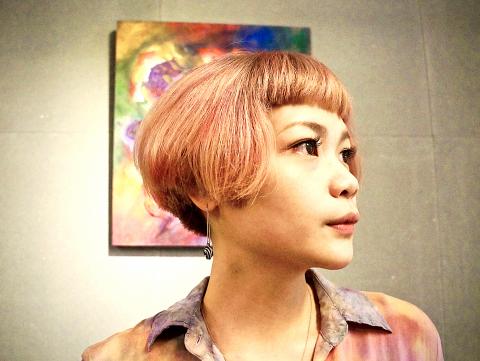
Photo: Jules Quartly
Nowadays, it has a faded elegance, dotted with colonial-era buildings, their balustraded balconies overflowing with plant pots full of weeds, engine repair shops, barbers, curio stores and cool eating places. There’s a modern bespoke tailor opposite her studio — “We are not a factory but a group of tailors.” It’s post-industrial chic, the Taipei of laid-back artist types in a mixed residential area, down the backstreets from Shuanglian MRT.
Though Panay doesn’t like the tie-dye stereotype, the term does come from the flower power era of the 1960s. Created by folding, pleating or tying the cloth in a process called “resists,” the dye only partially covers the textile and typically produces bold, saturated colors that are totally unique every time — a bit like the LSD trips they are associated with.
So far, so far out, but actually tie-dye is an ancient art, with extant examples from pre-Colombian Peru. It is Asia, however, where tie-dye really flourished. In Japan it’s called shibori and dates back to the 8th century, while the similar wax-resist dyeing of batik from Indonesia is world renowned. Meanwhile, in China, the Bai ethnic group in today’s Yunnan Province was famed far and wide for its tie-dye techniques, mainly with indigo-plant-based colors.
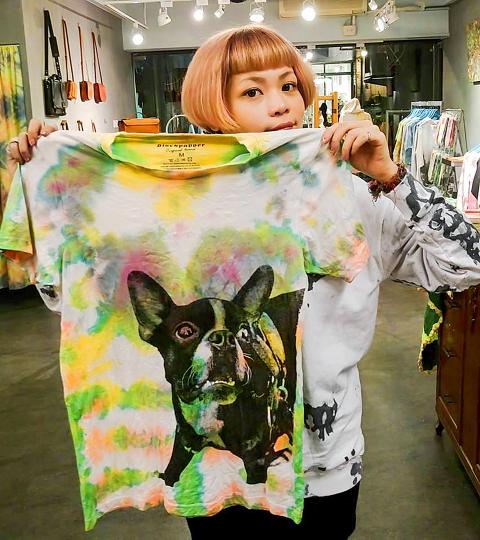
Photo courtesy of Panay
Panay is keen on the idea of modernizing the craft. Not so much by using new chemicals, as she’s keen on a natural or eco approach, but by producing new motifs and pattern schemes. She calls it “hand dye” rather than tie-dye and produces shirts, dresses, bags and all manner of other fashionable textile-based clothes. You’ve probably seen her brightly colored leggings and stockings around town, as they get a lot of media attention and sell well.
Since opening her studio store just over a month ago, business has been fairly brisk. A lot of the customers are Japanese, South Korean or from Hong Kong, keen to explore Taiwan’s diversity. Locals, on the other hand, tend to be more conservative and prefer something more button-down, American themed T-shirts or something even less adventurous.
This is about education to some extent, hence the reason why Panay is running courses on hand-dyeing, which attracted 30 people on a recent weekend. She showed them how to prepare, resist and fix the colors, while introducing the plants, nuts and bulbs she sources from all over Taiwan for her dyes. They include old petals from Cape Jasmine, which makes a yellow-eggshell color; fallen betel nuts make a watermelon red; onions, skin ‘n’ all, make a light brown or tan color; while her grape/cherry mix creates a purple dye.
The basic garments are bought according to the season at the wholesale fabric market on Bihua Street (碧華街) in New Taipei City’s Sanchong District (三重), which used to be at the center of the country’s textile trade. Then she ties, binds and bundles them up depending on the design she wants to create. “I always cook up the dyes myself because then they are more beautiful,” Panay says. “The results depend on the temperature, humidity, season and my mood. Yes, of course I have secret recipes, but they wouldn’t be secrets if I told you.”
Something not to say about Panay, is that she is an “Aboriginal designer.” Just as not all redheads are sexual athletes; not everyone who wears glasses is an intellectual; and just because you speak Mandarin it doesn’t mean you’re inscrutable: The danger of being labeled or put in a box is, you may not be able to get out of it. Instead, she describes herself as a Taiwanese designer.
“If you tell someone that it’s Aboriginal design, then people expect you to sell it cheaper,” she says.
So, Panay (which means “wheat” and “strong” in the Amis language) is a little reluctant to emphasize her Amis tribal roots to the media, because by doing so she fears being filed away under “Aboriginal” and that’s as far as her brand will go. This is not to say that she isn’t proud of being Amis. On the contrary. Once warmed up, she’s quick to list prominent Amis people: rock musician, DJ and hip-hop artist Chang Chen-yue (張震嶽), the “Iron Man of Asia” and decathlete Yang Chuan-kwang (楊傳廣) and Council of Indigenous Peoples Minister Mayaw Dongi.
After studying fashion design at Shih Chien University, Panay was partly inspired by her family and friends back in Taitung to make clothes they could wear. She also ropes in the relatives to help her source ingredients for her dyes up in the mountains. But it was a years-long apprenticeship at Shin Kong Mitsukoshi department store as a sales assistant that really crystallized the idea of starting her own brand.
“I learned how to sell clothes, talk to customers and learn what they wanted. I could see that Taiwan brands were well organized but found they didn’t really transmit a message, a concept, a story from the designer to the customer. In a way, the designer did what they like but wasn’t bothered with the selling. I saw this and thought I could do it better.”
So, the “tribal hand dyed” concept was born and given the name DanDan, which means “red.” It’s also the color of her tribe, and sounds like dang (担), which means responsibility, or resolved to be successful. The idea is to produce native designs with a twist. Reflect her tribal culture but not be defined by it.
“I’m proud of my culture but there are still problems, like some of my relatives have land on the mountain and it’s being taken or abused. We want respect, so that’s also what this company and brand is all about and why I’m working so hard to be successful.”
“I’m kind of married to business, for better or worse. I want to go back to Taitung when I’ve learned all I’ve needed to learn and establish the brand,” she says, then smiles. “Yes, go back to the family and tribe and be a hippy again.” For more information about Panay, go to: www.facebook.com/dandan.design
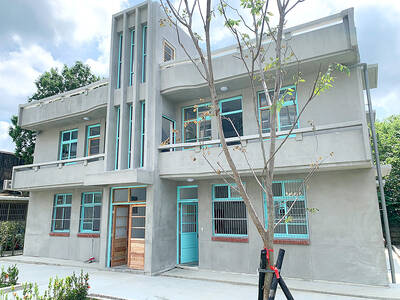
June 2 to June 8 Taiwan’s woodcutters believe that if they see even one speck of red in their cooked rice, no matter how small, an accident is going to happen. Peng Chin-tian (彭錦田) swears that this has proven to be true at every stop during his decades-long career in the logging industry. Along with mining, timber harvesting was once considered the most dangerous profession in Taiwan. Not only were mishaps common during all stages of processing, it was difficult to transport the injured to get medical treatment. Many died during the arduous journey. Peng recounts some of his accidents in
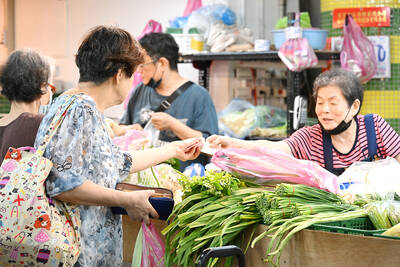
“Why does Taiwan identity decline?”a group of researchers lead by University of Nevada political scientist Austin Wang (王宏恩) asked in a recent paper. After all, it is not difficult to explain the rise in Taiwanese identity after the early 1990s. But no model predicted its decline during the 2016-2018 period, they say. After testing various alternative explanations, Wang et al argue that the fall-off in Taiwanese identity during that period is related to voter hedging based on the performance of the Democratic Progressive Party (DPP). Since the DPP is perceived as the guardian of Taiwan identity, when it performs well,
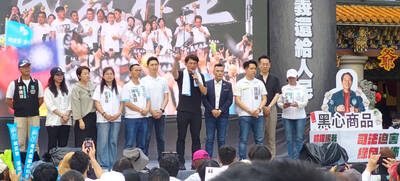
The Taiwan People’s Party (TPP) on May 18 held a rally in Taichung to mark the anniversary of President William Lai’s (賴清德) inauguration on May 20. The title of the rally could be loosely translated to “May 18 recall fraudulent goods” (518退貨ㄌㄨㄚˋ!). Unlike in English, where the terms are the same, “recall” (退貨) in this context refers to product recalls due to damaged, defective or fraudulent merchandise, not the political recalls (罷免) currently dominating the headlines. I attended the rally to determine if the impression was correct that the TPP under party Chairman Huang Kuo-Chang (黃國昌) had little of a

At Computex 2025, Nvidia CEO Jensen Huang (黃仁勳) urged the government to subsidize AI. “All schools in Taiwan must integrate AI into their curricula,” he declared. A few months earlier, he said, “If I were a student today, I’d immediately start using tools like ChatGPT, Gemini Pro and Grok to learn, write and accelerate my thinking.” Huang sees the AI-bullet train leaving the station. And as one of its drivers, he’s worried about youth not getting on board — bad for their careers, and bad for his workforce. As a semiconductor supply-chain powerhouse and AI hub wannabe, Taiwan is seeing